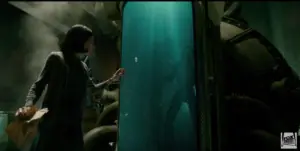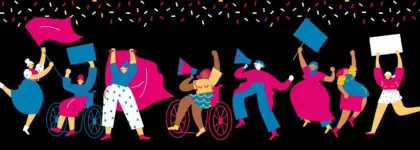10 Movies to Watch with Audio Description
August 6, 2018 BY ELISA LEWIS
Updated: August 30, 2023
Visual effects are so critical to cinema and film, that there is an Oscar category dedicated to this art. Not only are these visual effects utterly impressive, they also enhance the video content and provide a great deal of information and context to the audience. But for blind and low vision audiences, these visual effects are often left a mystery at best unless there is audio description.

Audio description is an audio track that narrates the relevant visual information in a video or performance. Standard audio description is typically dispersed throughout the natural pauses in the source audio, while extended description pauses the source video to make room for description. Audio description helps to provide the crucial information of the visual content in a cinematic way. Even sighted people can enjoy the detailed descriptions, especially when multi-tasking and not looking at the screen. We’ve made a list of 10 movies to watch with audio description. Want to see more audio described titles? Check out this full list of audio description movies!
The Beginner’s Guide to Audio Description➡️
1. Avatar
Soon after hitting theaters in 2009, Avatar became one of the highest grossing movies of all time. Using the newly invented (at that time) motion capture technique, 3-D viewing and the use of stereoscopic filmmaking, it’s no surprise that the film won an Academy Award, in addition to several other awards for its visual effects. This film is available with audio description, and we highly suggest you take the time to listen to it!
![]()
Photo: Avatar
2. Avengers: Infinity War
With an estimated budget of $300 – $400 million, Marvel’s Infinity War is one of the most expensive movies ever created. Wondering why it cost so much? Sorry to be the bearer of bad news, but those elaborate costumes and scenery were actually created digitally. It took 13 visual effects companies to create the incredibly detailed characters and scenes in this movie. Missing out on the astonishing visual effects in this movie is not only missing a huge part of what’s happening, but also missing out on brilliant works of art. The comparisons below show you what it actually looked like when filming, compared with what it looks like on screen. In many scenes, the footage was shot with green screens and minimal costuming, only to be digitally created later on.

Photo: Avengers: Infinity War
3. Star Wars: The Force Awakens
For any Star Wars fans, I probably don’t have to give you reasons why this is a movie to watch with audio description (and in any other format you can think of, for that matter.) But if you’re looking for another reason, consider the visuals.
The Star Wars opening crawl is the signature of every Star Wars movie, and has become an iconic symbol that even non Star Wars fans recognize. The opening crawl begins with the static blue text, “A long time ago in a galaxy far, far away….”. None of the text is spoken out loud, so for those with vision loss, this iconic on-screen text which provides crucial information to viewers is missed if it is not audio described.
Star Wars Opening Crawl
4. Frozen
I don’t know about you, but hearing Olaf described as “a carrot nosed snowman shuffling up to a purple flower” is enough of a reason that Frozen is a movie to watch with audio description. Thanks to Pixar’s Disney Movies Anywhere App, which allows users to watch most Pixar films with audio description, you can watch this all-time favorite with incredible descriptions. It really doesn’t get much cuter!

Photo: Frozen
Everything You Need to Know About Audio Description
5. Inception
“I’ll say no more, except that Inception rewards the attention it demands.” – Rolling Stone
This unique and complex film follows a thief with the rare ability to enter people’s dreams and steal their secrets from their subconscious. As you might imagine, this leads to a pretty interesting storyline. If you think you would be able to follow this sci-fi/thriller without description that makes one of us.

Photo: Inception
6. Finding Nemo
This one is right up there with Frozen. (You’re likely starting to get a good sense of my movie taste.) Listening to Finding Nemo with audio description can take you on a wonderful deep sea dive through the Great Barrier Reef that you’ll enjoy even if you don’t like to swim. This Academy Award-winning animated film takes us on a journey below the sea. Without audio description, you’ll miss out on the vibrant aquatic life and sea creatures met along the way.

Photo: Finding Nemo
7. The Shape of Water
With a merman as this film’s romantic lead, who falls in love with the mute protagonist, you won’t want to miss The Share of Water with audio description. Don’t believe us? Watch the trailer. Trey Harrell, Visual Effects Supervisor, explained that “Every single shot in the film where the amphibian-man is on-screen is digital in some capacity — at least his eyes.” “For a small handful of shots in the film, he’s entirely digital.” Anything that is that complex to create should definitely be described. Plus, aren’t you curious how one describes a romantic merman?

Photo: The Shape of Water
8. The Hunger Games
Adapted from books which rely on internal monologue, The Hunger Games movie uses dialogue as well as visuals and cutaways to create a similar feel. In addition, although fewer than the number in the book there are several memory-laden flashbacks and a hallucination scene that would be difficult to understand without audio description. Compared to some of the others on this list, The Hunger Games may seem limited in its visual effects, but audio description is just as crucial to explain the context, for example in the scene depicted below where there is no dialogue as Katniss crosses a barbed wire fence with a sign on it that reads, “District Boundary No Access Beyond This Point” indicating possible danger ahead.
Photo: The Hunger Games
9. La La Land
One of the most striking things about La La Land is the colors used in the movie. You don’t have to be a student of art to know that color choices are critical to evoking different emotions, and setting the scene. But it’s not just color that makes La La Land a highly visual film – there are many other details that are carefully thought out, including the juxtaposition of the types of cars Sebastian and Mia drive, the shoes Mia wears (tap shoes during a twilight dance, rather than her previous heels.) These are the details that take La La Land to the next level, and if it weren’t for audio description they would be lost for blind and low vision viewers, and taken for granted by many sighted viewers.
Photo: La La Land
10. The Jungle Book
A new take on an old classic, this version of The Jungle Book certainly caught up with the times from a technological standpoint.
The new rendition of The Jungle Book was widely praised for its effective use of “virtual production.” The film was lensed entirely on a bluescreen stage in Los Angeles. The only live action in the film is the boy, Mowgli, and the small piece of set on which he stood or climbed. We’re sorry to be the bearer of bad news, but the rest of the film (including all of the animals and the jungle itself) was computer generated.
Robert Legato, the visual effects supervisor, phrased it best, “Each shot was its own science project.”
Photo: The Jungle Book
Further Reading

The Americans with Disabilities Act Celebrates 33 Years

Canada’s National AccessAbility Week

3Play Media Celebrates Global Accessibility Awareness Day (GAAD)

Subscribe to the Blog Digest
Sign up to receive our blog digest and other information on this topic. You can unsubscribe anytime.
By subscribing you agree to our privacy policy.
About 3Play Media
3Play Media provides closed captioning, transcription, and audio description services to make video accessibility easy. We are based in Boston, MA and have been operating since 2007.
Quick Links
Contact Us
77 N. Washington Street
2nd Floor
Boston, MA 02114
Tel: (617) 764-5189
Fax: (617) 245-0510
Site by 3 Media Web
©2023 3Play Media. All Rights ReservedFirst name*First nameLast name*Last nameEmail Address:*Email address
We’re committed to your privacy. By submitting, you agree that 3Play Media may use the information you provide to contact you about relevant content. You may unsubscribe from these communications at any time. For more information, check out our Privacy Policy and CPRA notice.
Movie
179 languages
Tools
From Simple English Wikipedia, the free encyclopedia
“Film” redirects here. For other uses, see Film (disambiguation).1:35:53CCNight of the Living Dead is a popular movie from 1968 that a lot of people think is one of the best horror movies ever[1]
A movie or film is a type of visual art that uses images and sounds to tell stories or teach people something. Most people watch movies to entertain themselves or to have fun. Some movies can make people laugh, but other movies can make them cry, or make them feel afraid.
Overview[change | change source]

Most movies are made so they can be watched at home or on a movie screen at movie theaters. Movies are shown in movie theaters a few weeks or months after or before the movie is released. Movies can be marketed using media. Movies are shown on pay television or cable television, or are sold or rented on DVD disks or videocassette tapes, so that people can watch the movies at home. Movies can also be downloaded or streamed. Some movies are shown on television broadcasting stations.

The Simple English Wiktionary has a definition for: movie.
Movies are filmed with movie cameras or video cameras. Movie cameras take pictures very quickly, and they usually take 24 or 25 pictures, or frames every second. When a movie projector, a computer, or a television shows the pictures at 24 frames a second, it looks like the things shown in the set of pictures are moving. Sound is usually recorded at the same time as the pictures are, but sometimes they are added later. The sounds in a movie are usually people talking, the soundtrack, and sound effects. In the 20th century the camera used photographic film.
Making movies[change | change source]
Most movies start to be made when a screenwriter writes a script, which is the story of the movie with dialogue and words and things that the actors will say and do. A producer hires people to work on the movie and gets the money that will be used to pay for the actors and the equipment. Producers usually get the money by borrowing it from a bank or by asking investors to give money to them. Some producers work for a movie studio, but other producers work by themselves.
Actors and directors read scripts to learn what to say and what to do. The actors learn the words from the script that they will say in the movie, and learn the things that the script tells them to do. Then, the director tells the actors what to do and a cameraman takes the film of them saying the words with a film camera.
When the filming is done, an editor makes the film play after each other, which makes a story. Audio engineers and sound engineers record music and singing and combine it with the film. When the movie is done, many copies of the movie are made by movie labs and put onto film reels. Then the reels are sent to movie theaters. A projector shines a very bright light through the film, and people sitting in a dark room see it on a big screen.
Types of movies[change | change source]
A genre means a type of movie. Movies can be fictional, or non-fictional. Even though hundreds of movies are made every year, there are not like another movie. Some movies can be two or more genres.
- Action movies are movies where the main character is in a dangerous situation, and the movies usually have a lot of violent things, like explosions, blood, and fight scenes. In Die Hard, terrorists take control of a skyscraper and ask for a big ransom. If they are given the ransom, they won’t killing the people who work in the skyscraper, who are called hostages.[2]
- Adventure movies usually have a hero who go on long journeys to fight big things, like dragons.
- Animated movies use drawn images like cartoons to tell a story. These movies used to be drawn by hand, one frame at a time, but they are usually now made on computers. They can be 2D animated or 3D animated.[2]
- Buddy movies involve two friends. Buddy movies usually have comedy. Buddy cop movies are a common theme.
- Comedies are movies about funny scenarios that characters might be in.
- Comedy horror movies blend horror and comic motifs in its plots. Movies in this genre sometimes use black comedy as the main form of humor.
- Documentaries are non-fiction movies that are (or claim to be) about real people and real events. They are nearly always serious and may involve strongly emotional subjects, for example cruelty.
- Dramas are serious, and often about people falling in love or needing to make a big decision in their life. They tell stories about relationships between people. They usually follow a basic plot where one or two main characters (each actor plays a character) have to ‘overcome’ (get past) an obstacle (the thing stopping them) to get what they want.
- Family movies are made to be okay for children to watch. Disney is famous for their family movies.
- Fantasy movies include magical and impossible things that any real human being cannot do.
- Film noir movies are 1940s-era detective dramas about crime and violence.
- Horror movies use fear to excite the audience. Music, lighting and sets (man-made places in movie studios where the movie is made) are all designed to add to the feeling.
- Romantic Comedies, also called “Rom-Com”s are usually stories about 2 people who fall in love, and do funny things or have funny things happen to them.
- Science fiction movies are fiction and also have a lot of science, and have machines that can not be built in real life yet.
- Sports movies tells stories that involve sports. They are often a form of drama where athletes must overcome some issue.
- Suspense movies makes the audience stressed. They usually have multiple twists that confuse the people watching the movie
- Thrillers are usually about a mystery, strange event, or crime that needs to be solved. The audience is kept guessing until the final minutes, when there are usually ‘twists’ in the plot (surprises).
- Tragedies are a type of dramas. They are about people in trouble. For example, a husband and wife who are divorcing must each try to prove to a court of law that they are the best person to take care of their child. Emotion (feelings) are a big part of the movie and the audience (people watching the movie) may get upset and even cry.
- War is a movie genre concerned with warfare. They are normally about naval, air or land battles. They have combat scenes central to the story. These stories are most commonly set in the 20th century.
- Western movies tell stories about cowboys in the western United States in the 1870s and 1880s. They are usually action movies, but with historical costumes. Some involve Native Americans. Not all movies that are set in the American West are made there. For example, Western films made in Italy are called Spaghetti Westerns. Some films can also use Western plots even if they are set in other places.
Business of making movies[change | change source]
Most movies lose money but some make up to hundreds of millions. In India movies have become an enormous part of the economy. The industry has always been led by a few major movie studios like MGM/UA, Warner Bros., Columbia, Paramount, or Disney.
Elements[change | change source]
There are many large companies that provide all of the services needed to make movies, such as special effects, lighting, set building. Many of these employees belong to trade unions who say how much their members must be paid. A large number of smaller companies also offer services, such as music studios (which record the music for original movie sound tracks) and CGI computer animation.
Distribution[change | change source]
Finally there are movie distribution companies (Which send movies around the world or around a country), and advertising companies (Showing people who may watch the movie so they do it.)
Movies with famous stars (actors who are well known) and large budgets (lots of money), are designed to have a large appeal (something a person would like about the, so that hopefully millions of people will pay to see them. These most expensive movies are called blockbusters.
Special effects can add a huge amount to the cost of a movie, especially the newest CGI effects, but people have come to expect them and every blockbuster movie tries to outdo the last. Even in 2008, some movies cost up to $200 million to make.
Very successful movies can make many times that amount in profit, and that’s why the studios keep producing them. This kind of movie will have a lot of promotion (getting the movie into the public.) through television advertising, billboards and internet sites.
Blockbuster[change | change source]
In blockbuster movies, there is usually a happy ending, in which all of the problems in the plot (story) are figured out or fixed and almost everyone (except the bad guys) live happily ever after. Some movies have been so successful that the studios keep releasing more and more sequels, or movies with the same characters and basic plots.
Indie films[change | change source]
At the opposite end of the scale to the blockbuster, there is the independent, art, or Indie movie. These are usually made by small movie companies, or even just a small group of people that do not have much money. An example is The Blair Witch Project, which cost only about $60,000, but which has so far taken perhaps $200 million in ticket and DVD sales. Movies like this are very unusual and usually become popular ‘underground’ (word of mouth advertising), so that they have a cult following, or popular but not mainstream.
Independent movies often tell more creative or unusual (strange) stories, or may have sad endings that do not appeal to the big studios, because they can not be sure how the public will react to them. They rarely make a lot of money, but if they are successful, the big studios will quickly try to get the people involved to sign a contract with them, by offering them a lot of money to make another movie. Often the new movie, with its big budget and its stars will be less successful than the first.
The Oscars[change | change source]
Some movies received Oscar nominations, and wins. Also, some actors and actresses received Oscar nominations, and wins.
Age appropriate ratings[change | change source]
Movies have age appropriateness. Some examples include G, PG, PG 13, and R.
Related pages[change | change source]
- Big Ten (movie studios), America’s ten largest movie studios
References[change | change source]
- ↑ “Empire Features”. 2012-01-18. Archived from the original on 2012-01-18. Retrieved 2022-06-24.
- ↑ Jump up to:2.0 2.1 “90+ Film Genre Examples for Film & TV”. StudioBinder. 2020-12-13. Retrieved 2021-02-25.
Other websites[change | change source]

Wikimedia Commons has media related to Movies.

 Users Today : 1
Users Today : 1 Users Yesterday : 0
Users Yesterday : 0 Users Last 7 days : 12
Users Last 7 days : 12 Users Last 30 days : 58
Users Last 30 days : 58 Users This Month : 58
Users This Month : 58 Users This Year : 313
Users This Year : 313 Total Users : 884
Total Users : 884 Views Today : 1
Views Today : 1 Views Yesterday :
Views Yesterday :  Views Last 7 days : 20
Views Last 7 days : 20 Views Last 30 days : 103
Views Last 30 days : 103 Views This Month : 103
Views This Month : 103 Views This Year : 547
Views This Year : 547 Total views : 3071
Total views : 3071